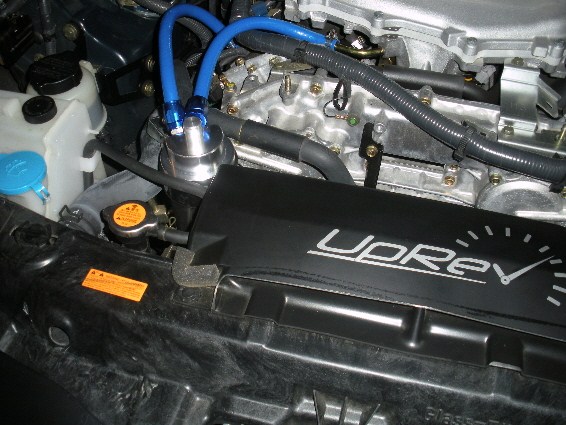How To Install Oil Catch Can 350z
Purpose of your Stock PCV System: The PCV (Positive Crankcase Ventilation) system is designed to regulate and remove fumes from the engine crankcase, and to alleviate crankcase pressure which could cause oil leaks or seal damage. It’s a way for gases to escape in a controlled manner from the crankcase of an internal combustion engine. During normal operation of an internal combustion engine, there’s a compressed air and fuel mixture inside the combustion chamber that is ignited and as a result, forces the piston down. A small amount of that ignited mixture leaks past the piston rings and ends up in the crankcase. This leakage is often referred to as “blow-by” (leakage past the piston rings), as well as oil mist. Some of the oil mist and other products settle along the engine intake and over time form a “gunk.” The oil catch can collects the oil mist and condenses the fuel vapors while allowing “cleaner” gases to be passed back into the intake.


Race Oil Catch Cans Race Overflow & Expansion Tanks. Fineprint V9 Incl Keymaker Rar Download Free. Nissan 350Z, 2003-2009 / Infiniti. 2003-2009 / Infiniti G35, 2003-2007 (Coupe only) Oil Cooler Kit. Make sure the oil return line has no kinks in it for it has to drain freely into the oil pan. We then proceeded to hook up the tee fittings for the oil feed line.
Typically the blow-by gasses are passed through a wire mesh, which give the vapor droplets something to adhere to. Since the oil catch cans condense the vapor portion of the gasses, they will need to be drained periodically of all the oil, fuel and other contaminants. In addition to the air/fuel mixture and oil mist, there’s also the possibility of condensation, or water droplets. Condensation is more susceptible in humid climates, but it can exist anywhere there is fluctuation in temperatures in a hot to cold environment. Biblia De Bosquejos Y Sermones Apocalipsis Pdf To Excel. If these contaminates are kept inside the combustion chamber, they will eventually make their way into the oil inside the crankcase and cause oil contamination and dilution or make their way back into the intake manifold. This problem has been around forever.
In the past, engines were equipped with breathers that would allow the crankcase to “breath”. The addition of these breathers resulted in moderate engine life improvement.
However, it was not until the engine’s crankcase was fitted with a vent or evacuation tube that major improvements were experienced. A PCV (Positive Crankcase Ventilation) system exists to help counter this problem and expel the gases out of the crankcase and back into the intake manifold. Because the intake manifold is at a lower pressure than the crankcase, suction is created keeping the PCV system going.
On engines equipped with a turbocharger, a check valve is sometimes used to prevent pressurizing the crankcase during boost. Click to Animate First there was nothing more than plain breathers to allow excess crankcase pressure to be released or vented. But the damage from not “flushing” all the gasses out resulted in very short engine life (of course the oils of that day were nothing like the protection today’s synthetics provide) so the next change added a vent tube, or evacuation tube that ran from the top of the crankcase to low on the car where the air streaming past would create a suction, or vacuum that would pull the vapors out and vent them directly into the air with a breather (barely filtered with a wire mesh type media that was oiled to catch dust & dirt) allowing the “fresh” makeup air in to complete the flushing process. Now this resulted in greatly increased engine life, but as the motors got worn oil would start to drip out the tube and drip onto the roadways, then the rain would wash it into the ditches, where it would enter the ground water (you know the rest of the EPA story) and the gasses just vented to the air. As the EPA and the powers that be mandated stricter emission laws the system was refined more and more ultimately evolving into what we have today.
A completely sealed system that uses the vacuum provided by the intake manifold to draw these vapors out, and the filtered fresh makeup air is drawn from the main air intake system and filtered by the main air filter. This results in very clean emissions, but the unintended issues are the detonation or “knock” that occurs when oil is introduced into the combustion chamber that the knock sensors pick up (before we can hear it) and pull timing to protect the engine from damage, and thus reduced power. Consequences By Aleatha Romig Pdf Free Download. Another result is the carbon buildup on the valves & piston tops (any techs reading this can surely verify the amount) also resulting in decreased performance and less power made.
The purpose of a proper oil separating catch can is to route these gasses through a baffle system that provides the most contact possible with the outer surface resulting in the oil being trapped and removed from the other gasses that do continue on through the intake and are burnt and consumed. It does NOTHING else in ANY way to the engine oil itself.it can’t. Not all Catch Cans are created equally!